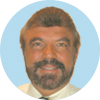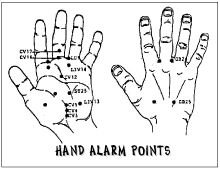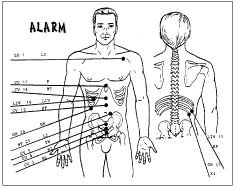Each of the specific acupuncture meridians has an alarm point on the anterior side of the body which is located over the organ for which it is named, i.e., the lung meridian is over the lung, the gallbladder meridian alarm point is over the gallbladder, etc. All but two of the alarm points are on the chest and abdomen. Those two points are found at the tip of the eleventh and twelfth rib and correspond to the spleen and kidney meridians, respectively.
Master Asian acupuncturists use these points extensively, but the typical contemporary practitioner has a tendency to disregard these points in favor of others. In my opinion, to ignore these points is perhaps one of the worst mistakes a practitioner can make.
I like to refer to the alarm points as being the circuit box of the body. If a health condition exists and a meridian is involved, it will "trip a circuit breaker." If the lung meridian is involved in a case of bronchitis, the lung alarm point is the localized therapy for those skilled in muscle testing (applied kinesiology) but will also be acutely tender to palpation.
There are a number of factors concerning acupuncture which are extremely significant in the diagnosis and treatment of meridians. For example, the functions of the skin are controlled by the lung meridian; muscle and ligaments are controlled by the liver meridian; and hearing is controlled by the kidney meridian. Emotions such as grief, sorrow, worry, fear and anger are associated with individual meridians, as are environmental factors, which may trigger disease processes.
One of the primary treatments involving the principle of acupuncture, which virtually any practitioner may employ, is to simply palpate and treat the tender alarm points. Since each alarm point is directly associated with a specific meridian, a general treatment approach affecting all of the alarm points would not be out of order. Treatment may consist of something as easy as firm, direct digital stimulation for 12-20 seconds per point, or simple electronic stimulation via one of the inexpensive but powerful electronic devices available today. Acupuncture is a principle not a technique. There are a number of acceptable ways (without needles) to treat an acupuncture point, although proper needle procedures to these points create dramatic effects.
One of the easiest methods, and one in which your patient may participate, is to utilize the Koryo Sooji Chim or Korean hand system to generally stimulate one or all of the meridian alarm points. In 1971, a complete system of acupuncture was discovered which today has over 20,000 practitioners internationally. These practitioners practice a system of acupuncture that employs nothing more than the use of specific points on the hands. Each meridian point on the body has a corresponding point on the hand.
Examine the charts of both the body alarm points and the Korean hand system. General stimulation of these points will provide dramatic response. Even if you are a neophyte in acupuncture, using the points shown here is easy, effective and available. I strongly urge you to use these points.
Here is my wish to you for a wonderful holiday season and the best in 2000, "The Year of the Dragon"!
Click here for previous articles by John Amaro, LAc, DC, Dipl. Ac.(NCCAOM), Dipl.Med.Ac.(IAMA).







